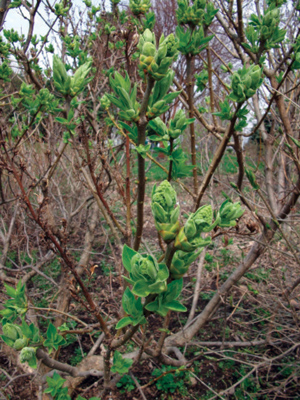The following story appeared in the May-June 2010 issue of Upstate Gardeners’ Journal.
******************
by Michelle Sutton
My life has been a continuous fulfillment of dreams …
The earth is good. It is a privilege to live thereon.
—Liberty Hyde Bailey

Ted Collins. Photograph by Michelle Sutton
Many articles have been written about Ted Collins, a.k.a, Doc Lilac, 82. Most Rochester area gardeners know, for instance, that he founded the Ted Collins Tree and Landscape Company and ran it for 44 years before turning the company over to his protégés ten years ago. But there are many things about Ted that maybe aren’t as well known:
- He is one of ten children, number eight in the birth order.
- His father worked as superintendent of Rochester’s Riverside Cemetery, and their family grew up there in a 14-room house. His mother grew lilacs in the cemetery and his father managed the trees and landscape.
- Ted studied horticulture at Charlotte High School for six years, from seventh through twelfth grade. He earned a degree in Ornamental Horticulture from SUNY Farmingdale in Long Island.
- In the 1960s, Ted worked for six years as the tree supervisor for Rochester’s Oak Hill Country Club.
- He began his landscape business in an abandoned gas station in Charlotte but after ten years moved to the basement of the red barn in Pittsford’s Schoen Place. Eventually he bought the barn, coal tower, and some other buildings there, which he still owns.
- Ted and his wife Janice, a retired schoolteacher, have been together for 60 years.
- The 15-acre Lilac Hill Nursery in Victor is a family affair: son Matthew and grandsons Andrew and Jason work in the business.
- When Ted retired from his landscaping business, before opening his lilac nursery, he spent one year hunting, fishing, and identifying wildflowers—all the things he’d wanted to have time to finally do—and quickly got bored. By contrast, when he got into the lilacs, he became “obsessed, captivated, and entranced.”

Syringia ‘Rochester’ Image courtesy Ted Collins
Having visited with Ted, I’d like to suggest a treasure hunt of sorts, to be undertaken in May. Ted would like this idea because it means you have to go to his 15-acre Victor nursery, Lilac Hill, in person to participate. And once you’re there and engulfed in lilac fragrance and beauty (and Ted’s charm), you will surely want to buy lilac plants, bouquets, and/or perfume.
The first thing you should look for—and this won’t take long to find—is Lilacia, the rearing fiberglass horse covered in lilacs. This was painted by artists Heather Heffernan and Amy Frank for the Rochester Horses on Parade exhibition for charity in 2001. Lilacia—so named by Ted—had two owners before he acquired her.
As you are cruising around Lilac Hill, find the Rochester Lilac, the first multipetaled lilac ever to be discovered. Syringa vulgaris ‘Rochester’ was a chance seedling that was found in the 1950s by then Rochester Director of Parks Alvan Grant and Superintendent of Parks Richard Fenicchia. In the Highland Park nursery, in the vicinity of a white lilac called ‘Edith Cavell’, they noticed a stout seedling with unusually thick leaves. The story goes that Grant transplanted it to his home nursery and when it flowered years later, he was blown away by the seedling’s properties.

Syringa ‘Rochester’ buds candelabra-like flowers. Photograph by Michelle Sutton
Until then lilacs were only known to flower in four petals—sometimes with two sets of four, in the case of doubles. What came to be called ‘Rochester’ was unique in that it was radially doubled, with up to 25 petals per flower. The new lilac also had the desirable trait of bearing its flowers high up in the canopy, looking very candelabra-like, on ultra-sturdy stems. The shrub also has a different habit from typical Syringa vulgaris—again, more like a tidy candelabra. ‘Rochester’ went on to become what lilac expert Father John Fiala (Lilacs: The Genus Syringa) called, “… the most outstanding lilac ever produced—both for its intrinsic beauty and also its extraordinary genetic makeup for hybridizing.” Richard Fenicchia used ‘Rochester’ extensively in his hybridizing work, developing a whole series of “Rochester Strain” lilacs for which he won the International Lilac Society’s highest award. There’s a good chance the compact lilac in your yard has some ‘Rochester’ parentage.
At Lilac Hill you’ll find that Ted has the ‘Rochester’ specimens spread out through the nursery, because when he grew them clustered together, they seemed to become stunted. Eventually he determined that they were suffering from bacterial infections (presumably from rainsplash-transmitted Pseudomonas) and moved them further apart from one another. This simple adjustment has helped them regain their vigor. ‘Rochester’ is difficult to propagate—Ted gets maybe five “takes” for every hundred tries—so he doesn’t have as many for sale as he would like. If you do buy one, be patient—it’s a slower grower than most lilacs you might be used to.

Former Rochester Horses on Parade Horse by Aimee Frank and Heather Heffernan Ted calls Lilacia. Photograph by Michelle Sutton
Fragrant lilacs are scattered through the Lilac Hill demonstration gardens and mass assembled in the show greenhouse in May. Doc’s favorites for fragrance include ‘Beauty of Moscow’ with rose buds that open to double pink to white flowers, and ‘Silver King’, with silvery white flowers with pink and blue mottling. The flower clusters are so large that one stem makes its own bouquet. (Doc was once asked to extract fragrance for a perfumer and found, with the help of a tip from wife Janice, that the best low-tech way to gather essence was to crush flowers in a garlic press lined with cheese cloth.) Also look in the gardens for the unusual weeping lilac, Syringa juliana ‘Hers’ with lavender flowers.
As you might expect, Doc has an interest in trees and shrubs generally. You will see seven-son trees (Heptacodium miconioides) in several places in the demo gardens. Seven-son tree blooms in late summer to early fall and the bees and butterflies adore it. There are numerous paperbark maples (Acer griseum) including some gorgeous large ones around his house. Working against its more loose and open natural growth habit, Doc has tightly pruned an Austrian pine (Pinus nigra) to create a perfectly columnar, full to the ground, long-needled evergreen of seemingly mystifying origin. Finally, look for three arborvitae (Thuja sp.) that have been severely limbed up by browsing deer, but which have ended up as an unintentional homage to formal Italianate gardens; Janice calls them the “Dr. Seuss Trees.”
Michelle Sutton (formerly Buckstrup) is a horticulturist in Rochester, New York.
Views: 40




